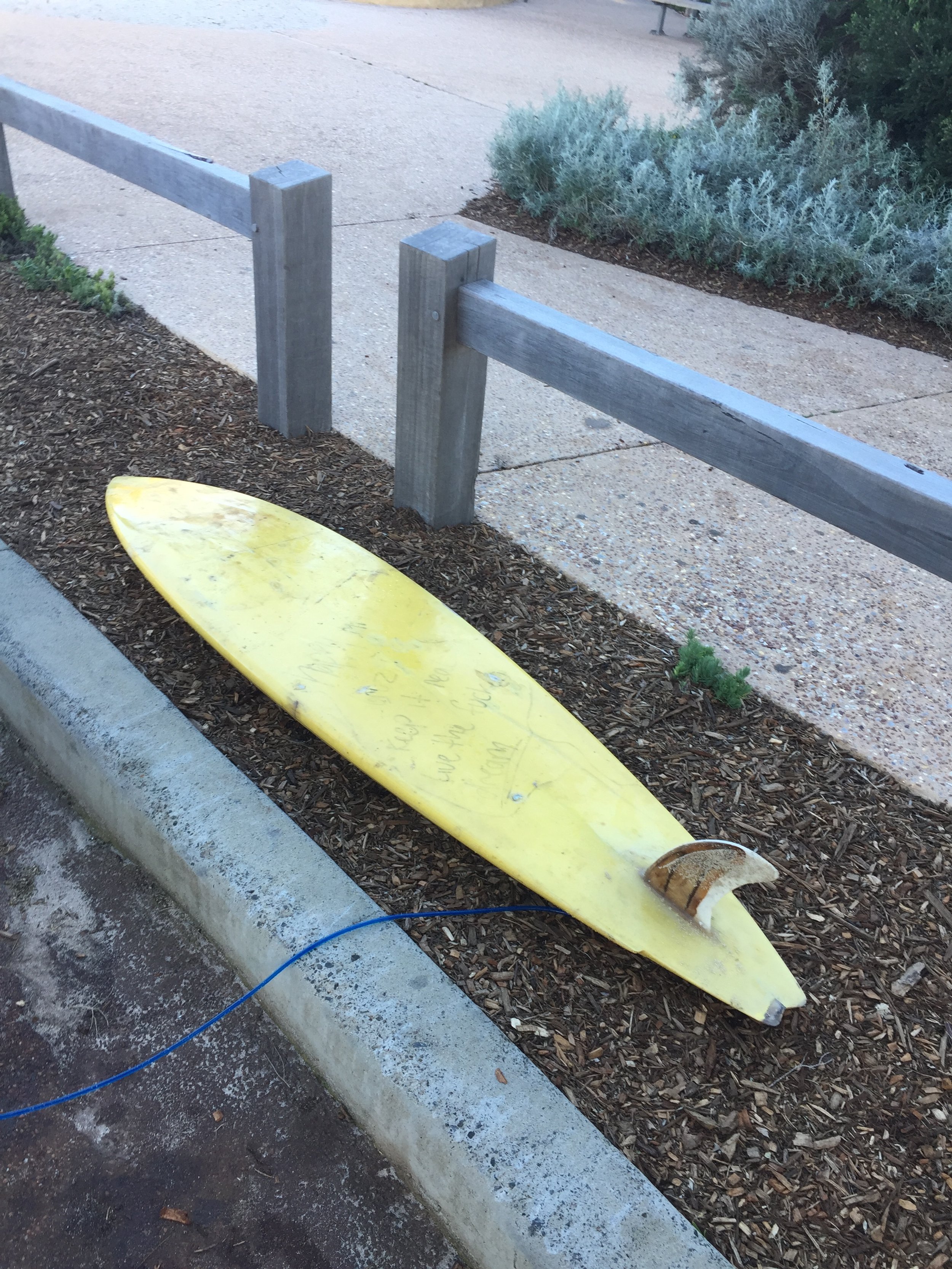Surfboards are a funny thing. To an outsider they might just look like an object, a hunk of fibreglass you use to ride waves.
But really, surfboards can be personal, deeply sentimental things. You might compare it to a car. Over time the thing becomes like an extension of you, a reflection of your personality.
It isn’t just an object, but a vehicle to an experience and all the of the triumphs and challenges and adventures that lie within.
Call it sentimental bullshit, but every now and then a board comes along that has the power to entirely reshape your relationship with that experience.
The first surfboard that did this for me was a bright yellow single fin I found lying on my bed on the morning of my 22nd birthday.
Single Fin. Post session.
My mate Benno had gifted me the board with a message handwritten in texta on the underside: “Happy birthday bruz live the fucken’ dream!’
At first glance, the value of this relic was lost to my youth. It was ugly thing, ancient-looking, probably 30 or 40 years old. It was a friggen’ tank too – six feet and eight inches long, and nearly three inches thick. A smattering of dings had been poorly repaired and other cracks and imperfections lazily circled with biro, but it was water tight.
I thanked Benno, stoked with the gift.
He told me what he knew of the board.
Benno had picked it up while on a nine-month surfing odyssey around Australia with a mate. They had been camping at Cactus, a basic but fabled surf camp on the edge of the South Australian desert, for six weeks. Two of Benno’s high-performance shortboards were in dire need of repair and he took them to a surfboard shaper in Penong, a nearby town of less than 300 people. Inside, he saw the two 1970s single-fins in the second-hand rack.
Something about the boards spoke to Benno. Maybe Benno is an old soul and it was just their vintage or aesthetic, but maybe these kinds of things also just come to you with a kind of serendipity.
After a bit of negotiation, Benno traded his shortboards for the single fins.
The shorter of the boards, which Benno kept for himself, appeared the superior of the two. It was a sleek, 6’4 winged Burford pintail with lime green tint. It was in pretty good nick.
Benno rode the board often, both on the trip and back at home in WA’s south west. When I moved in with him he allowed me to ride it sometimes at our local beach break. Other times, I snuck it out of the board rack when Benno wasn’t looking.
Meanwhile, the old yellow single fin sat unused in a dark corner of Benno’s shed. Soon enough he tired of me borrowing his board, and gifted me the other.
I didn’t think much of it when I first rode it in the fast, unpredictable beach-breaks. It floated high on the water and struggled to match the speed of the small, zipping waves. Coming from a high-performance shortboard to this thing was like swapping from a Ferrari to a front-end loader.
It was just a novelty at first, but the board garnered a bit of interest among other surfers. I couldn’t tell them much about it other than the information Benno had relayed me, until one morning a surfer in his 50s took particular interest in it.
“That looks like an old Tom Hoye,” he said. “He’s still here in Margaret River. Bloody legend. He’s aged 70-odd and still making boards by hand. You should take it to him. He’d be stoked to see it.”
Intrigued, I went looking for Tom one windy summer’s afternoon. I found him out back of his brick factory, all bright and wide-eyed, shocking white hair, a biker’s moustache, and a badly scarred leg; the result of falling 100 feet from a sea cliff.
Tom took the board and rested it up on a trestle.
“Wow!” he said. “Look at this thing. This takes me back. Late 70s, early 80s maybe.”
He ran his calipers and tape measure over the board, admiring the radical flutes in the flyers on the tail, the chines in the rails, and his patented five-stage bottom.
“It’s called the five-stage bottom because I use five flats to put it together. It breaks the bottom of the surfboard into five phases of plane. It’s not so much about each phase of plane but the transition points between them and the myriad of rockers in each phase,” said Tom.
“There are a whole bunch of different views to try and describe to you how those parts of a surfboard inter-relate, but like music and good art, it’s almost impossible to put into words.
“A great classical guitar player can tell you how they play the notes in a particular riff, but they can’t tell you how they did it. It’s about the space in between.”
Tom Hoye, examining one of his craft that has withstood the test of time.
Now that I knew some of the history and the thought behind this craft, I felt like I understood it a bit better. I started to ride it more, and I started to like it. The more I rode it the more I felt it ironing out the creases in my surfing.
Having mostly ridden high-performance shortboards, I had a flat, ugly approach to riding waves. I would use my body to wriggle and pump and generate speed, rather than allowing wave to do the heavy lifting.
This board demanded a smoother, more gentle approach. Just turning the damn thing required all of my energy. It left no room for unnecessary movement.
As I rode it more often, I noticed too that I began to read the waves better. The thing might have been a tank but it paddled like a Venezian gondola. It gave me time to glide in early and get a good read on the wave before it broke.
Single Fin and author, in action.
Surfing is an innate response, one of the few times where we can totally switch off and not think, only react instantly to an unfolding situation. This board slowed my surfing down, and honed and sharpened the muscle memories of those reactions.
It also meant that I had to be more aware of my positioning; navigating the thing was like steering a bulk carrier through a narrow shipping channel, and right from the take-off I had to be in the spot for the best chance of success.
Once you got it up on the plane though, the thing was virtually unstoppable. The long rail-line and eight-inch single fin would slice through tricky sections in a tube, and hold in high on the wave face.
You really had to ride the board with feeling, caressing it, rolling it gently onto a rail, not forcing it, just harnessing the natural speed of the wave and utilising its energy.
Often, it enhanced the simple pleasure of just gliding fast, effortlessly, along a breaking wave.
It totally simplified the act of riding waves, and forever changed the way in which I surf.



